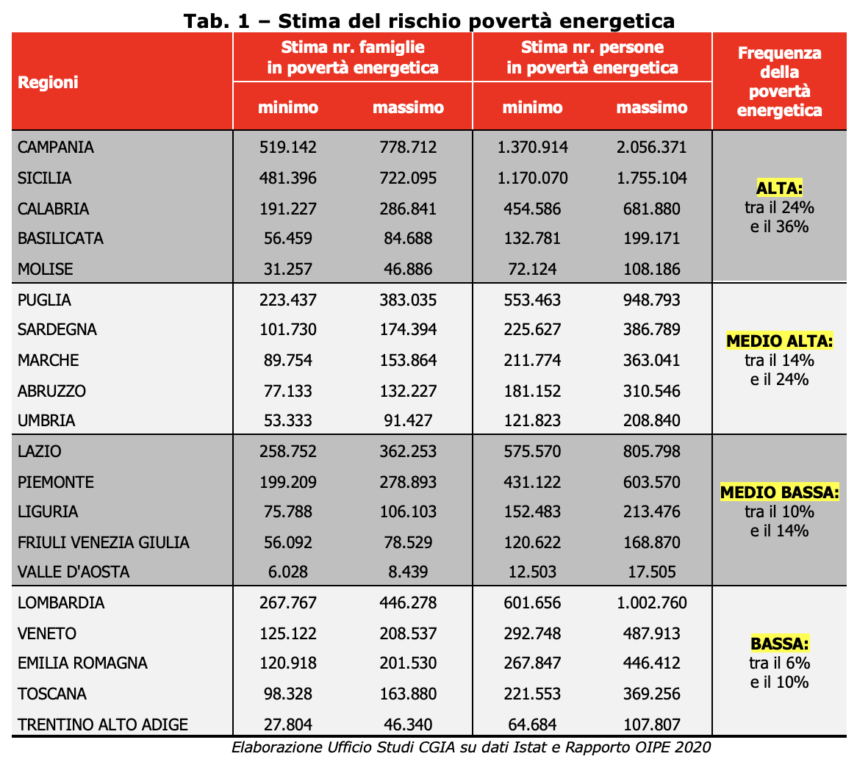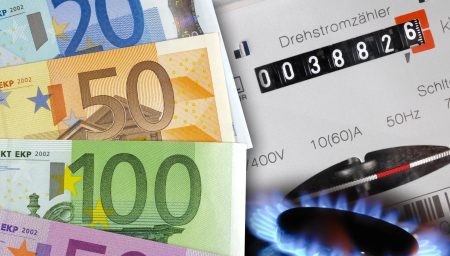It is estimated that the Italian families at risk of energy poverty are about 4 million; therefore, over 9 million people find themselves in this difficult condition. This emerges from the elaboration carried out by the CGIA Studies Office on the latest available data of the OIPE 2020 Report. Alarming data, also because certainly underpowered, since they were estimated well before the energy shock that broke out in our country starting from the second half of 2021.
According to the elaboration of the Venetian artisans, households are estimated to be in conditions of energy poverty who are unable to regularly use the heating system in winter, the cooling system in summer and, due to precarious economic conditions, do not they have or occasionally use appliances with high energy consumption (dishwasher, washing machine, dryer, vacuum cleaner, microwave, electric oven, etc.).
In the identikit of energetically “vulnerable” families we often find those with a high number of members who reside in poorly preserved housing, with the head of the family young, often unemployed and / or immigrant.
Geographically, the most critical situation occurs above all in the South: in this macro area the frequency of energy poverty is the highest in Italy and affects between 24 and 36 per cent of families residing in this area. In absolute terms, Campania is the region most in difficulty: the number of families that occasionally use electricity and gas fluctuates between 519 thousand and 779 thousand units. Equally critical is the situation in Sicily where the fork fluctuates between 481 thousand and 722 thousand households and in Calabria which has a range between 191 thousand and 287 thousand families in difficulty in the daily use of electricity and methane.
A little less critical, but in any case with a medium-high energy "vulnerability", we see the other regions of the South and some of the Center that have a range that varies from 14 to 24 per cent of resident families: Puglia (with a number of nuclei between 223 and 383), Sardinia (between 102 and 174), the Marche (between 90 and 154), Abruzzo (between 77 and 132) and Umbria (between 53 thousand and 91 thousand). The situation improves as you go up the peninsula. In the medium-low risk range (between 10 and 14 percent of the families involved), we note Lazio and some northern regions: Piedmont, Liguria, Friuli Venezia Giulia and Valle d'Aosta. Finally, in the lower band, the one that includes a number of families in difficulty ranging from 6 to 10 percent of the total, includes Lombardy, Veneto, Emilia Romagna, Tuscany and Trentino Alto Adige.

• The families of the self-employed are more at risk
The exponential increase in bill prices expected for next autumn could considerably worsen the economic situation of many families, especially those made up of self-employed workers. In recalling that about 70 percent of artisans and traders work alone, or have neither employees nor family collaborators, many artisans, small traders and VAT numbers are paying twice the extraordinary increase recorded in the last 6 months by the bills of electricity and gas. The first as home users and the second as small entrepreneurs to heat / cool and light their shops and stores. And despite the mitigation measures introduced in recent months by the Draghi government, energy costs have exploded, reaching levels never seen in the recent past. It should also be remembered that according to the latest data processed by Istat and referring to 2019, the poverty risk of families in Italy with a main income attributable to a self-employed worker was equal to 25,1 percent, against 20 percent attributable to families with main source of income from employment. And with the pandemic crisis and the consequent lockdown imposed on many "exploded" businesses at the beginning of March 2020, in the last 2,5 years the differential between these two family types could have even increased.
• The list of bonuses for those in difficulty
The 2022 bill bonus is an economic aid introduced by the Draghi government which allows families (domestic users) and businesses (non-domestic users) in difficulty due to expensive energy to mitigate, at least in part, the increase in their bills.
The most significant items are:
- strengthening of the electricity and gas social bonus for domestic users in disadvantaged conditions;
- reduction of VAT to 5 per cent on gas for both households and businesses;
- zeroing of general system charges for low voltage users (up to 16,5 KW);
- the possibility of paying bills in 10 installments, but only for those issued from 1 January to 30 June 2022 (previously the deadline set by the 2022 Budget Law was 30 April, deferred by the 2022 Energy Decree).
Who is entitled to the 2022 electricity and gas social bonus? The social bonus, which is part of the aforementioned benefits included in the 2022 bill bonus, is only for domestic users in difficulty, namely:
- nuclei with an ISEE below 12.000 euros (remember that for the first quarter the ISEE threshold was 8.265 euros, which was subsequently raised retrospectively: the ISEE index of 12.000 is also applicable for supplies in January, February and March 2022 and those who were previously excluded get compensation on the bills of the following quarters);
- large families with an ISEE of 20.000 euros per year and at least 4 children;
- the beneficiaries of the Citizenship Income or Citizenship Pension;
- users in precarious health conditions who use electro-medical equipment.
The Aid Decree bis, published in the Official Gazette last month, included, from 1 January 2023, among "vulnerable" customers also people over 75, retired and non-retired, and those who have utilities in the smaller non-interconnected islands or in emergency homes after a disaster.
